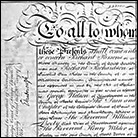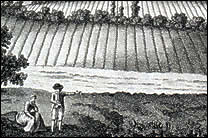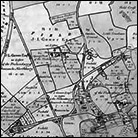|
For much of the eighteenth and early nineteenth centuries in
England
all occupiers of common-field land and many cottages shared common grazing over common fields and wastes. In forest and fen manors, and others with substantial uncultivated commons or well-defended customs, even the landless found pasture and collected fuel, food and materials.
Northamptonshire by the early 18th century had the least area of land turned over to enclosure in
England
; but in the period 1750 to 1819 more than 50% of the county had been changed over to enclosure. This took away from the general population the ability to be self-sufficient in the supply of foodstuff for the family. The process though made very little difference to the distribution of wealth - the King, the Barons and the Church had always taken the lion’s share and would continue to do so. Parliament paid little attention to the protestations of the population about enclosure of the common fields. Parliament put its activities into passing private acts for enclosure and the major changes in land usage in Northamptonshire came about through these private acts.
The historian Trevelyan summarises it as follows:-
| "After the 3rd decade of the 18th century the work began to be carried on by a new and more wholesale procedure: private acts of Parliament were passed which overrode the resistance of the individual proprietors to enclosure; each had to be content with the land or the money compensation awarded to him by Parliamentary Commissioners whose decisions had the force of law. This was the radicalism of the rich at the expense of the poor.” |
Enclosure brought about one of the greatest changes in the landscape of rural
England, as
it
was t
r
ansformed from huge open fields into
what
we now tend to regard as
the
'
traditional'
patchwork of
smaller
fields bou
n
ded by hedges
,
fences or walls
.
In central
England
and much of southern
England
the process reached its peak in the 18th and early 19th centuries.
It was the process which saw the privatisation of previously commonly held and used areas of land. The communal element was abolished and individual landowners and tenants took over separate, private control of defined areas of land. Ancient rights, customs and practices were set aside. And there were distinct winners and losers. The community no longer had rights over most of the land and the poorer members of village society were frequently disadvantaged in consequence. The process involved both a legal change and a physical change as ownerships and rights were altered, large open areas became smaller enclosed areas, and local maps were literally re-drawn. Physically, the great open fields, unfenced and unhedged meadows and pastures, and the expanses of fen, moor, common and heath were divided up into hedged, fenced or walled fields. The land was enclosed, instead of open.
In Burton Latimer, the area most affected was the Wold. Click here to read about the process of Enclosure in Burton Latimer and to see the Enclosure Map.
|


